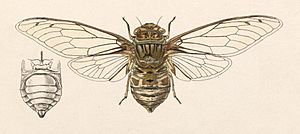Giant cicada facts for kids
Quick facts for kids Giant cicada |
|
|---|---|
 |
|
| Male Quesada gigas | |
| Scientific classification | |
| Kingdom: | |
| Phylum: | |
| Class: | |
| Order: | |
| Family: |
Cicadidae
|
| Tribe: |
Hyantiini
|
| Genus: |
Quesada
|
| Species: |
Q. gigas
|
| Binomial name | |
| Quesada gigas Olivier 1790
|
|
The Giant cicada (Quesada gigas) is a very large type of cicada. People also call it the chichara grande, coyoyo, or coyuyo. This amazing insect lives in North, Central, and South America. It is one of only two species in its group, Quesada. The Giant cicada can be found across more places than any other cicada in the Western Hemisphere.
Contents
History
Discovering the Giant Cicada
The Giant cicada was first found by Guillaume-Antoine Olivier in 1790. Later, in the 1840s, a British explorer named Henry Walter Bates wrote about their loud songs. He heard them while exploring the Amazon.
Where They Live Now
For a while, Giant cicadas were seen in Texas starting in 1934. But this group disappeared, maybe because of a long dry period in the 1950s. Since 2005, the cicada population has grown a lot in central Texas. Now, you can find them from central Texas all the way south to Mina Clavero, Argentina.
Description
What the Giant Cicada Looks Like
The Giant cicada is the second largest cicada in North America. Like other cicadas in Texas, its body colors help it blend in with its surroundings. These insects are usually a mix of black, green, and brown patterns. They have brown eyes and their "neck collar" (called a pronotal collar) can be brown or green. In Texas, different types of cicadas are often told apart by their sounds, not just by how they look.
Distribution and Habitat
Where Giant Cicadas Live
The Giant cicada is the only type of Quesada cicada found in North America. In the United States, it mostly lives in the brushlands of south Texas. These areas stretch from the southern border up to around Austin, Texas.
Further south, you can find them in forest parks in Brazil. They also live in the tropical cloud forests and rain forests of Argentina.
What They Eat
Giant cicadas eat sap from many different kinds of plants. They are also able to control their own body temperature. This means they can live in many different environments, from warm to cooler places.
Song
The Giant Cicada's Loud Call
Giant cicadas make a very special and loud sound. In central Texas, they usually sing at dusk (when the sun goes down). They sing less often at dawn (when the sun comes up). Further south, they are known to sing all day and sometimes even through the night!
Their loud, high-pitched song has been described in many ways. Some say it sounds like a siren or an alarm. Others think it sounds like a whistle or gas escaping from a pressure release valve. Even though Giant cicadas live in a huge area, their song sounds almost the same everywhere they are found.
Life cycle
How Giant Cicadas Grow
Young Giant cicadas spend at least four years living underground. During this time, they are called nymphs. They feed on the roots of trees. They especially like the roots of Huisache trees or other plants in the legume family.
After growing underground, they come out as adult cicadas. In south Texas, they usually appear between April and October. In central Texas, they emerge from June to July.
See also
 In Spanish: Cigarra gigante para niños
In Spanish: Cigarra gigante para niños

